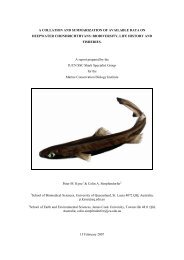30 Years of shark fishing in west africa - Shark Specialist Group
30 Years of shark fishing in west africa - Shark Specialist Group
30 Years of shark fishing in west africa - Shark Specialist Group
You also want an ePaper? Increase the reach of your titles
YUMPU automatically turns print PDFs into web optimized ePapers that Google loves.
Salted and dried meat <strong>of</strong> <strong>shark</strong> on <strong>fish<strong>in</strong>g</strong> zone <strong>of</strong> Kamsar <strong>in</strong> Gu<strong>in</strong>ea . (J. Dossa)<br />
<strong>Shark</strong> f<strong>in</strong>s on board <strong>of</strong> a vessel that had practiced f<strong>in</strong>n<strong>in</strong>g <strong>in</strong> Cape Verde. (I. Ndiaye)<br />
fish merchants (particularly, Senegalese),<br />
who paid to have them exported to Senegal.<br />
There were few wholesale fish merchants,<br />
and sometimes the fishermen<br />
exported the products to Senegal themselves.<br />
The highly sought after <strong>shark</strong> f<strong>in</strong>s only<br />
represented on average about 5% <strong>of</strong> the<br />
total weight <strong>of</strong> the <strong>Shark</strong>s (Ocean, 2010)<br />
and the carcasses were transformed <strong>in</strong>to<br />
smoked, salted and dried, or fermented<br />
and dried meat for the local market. The<br />
dried meat was sold <strong>in</strong> Ghana, whereas the<br />
smoked product was consumed <strong>in</strong> many <strong>of</strong><br />
the countries <strong>in</strong> the coastal area.<br />
Locally, the wives <strong>of</strong> fishermen have<br />
always played a very important role <strong>in</strong><br />
the salt<strong>in</strong>g and dry<strong>in</strong>g or ferment<strong>in</strong>g and<br />
dry<strong>in</strong>g (guedj) <strong>of</strong> the fish purchased or<br />
received from their husbands. Still today,<br />
the wives <strong>of</strong> Senegalese fishermen perform<br />
this activity on ‘fishermen’s beach’ <strong>in</strong><br />
Nouakchott, Mauritania.<br />
The European market<br />
In Mauritania, at the beg<strong>in</strong>n<strong>in</strong>g <strong>of</strong> the<br />
1900s, fishermen us<strong>in</strong>g overnight nets to<br />
catch smooth hounds (Mustelus mustelus),<br />
the best known and most abundant <strong>shark</strong>s<br />
<strong>in</strong> the northern Mauritanian waters, for<br />
the Canary Islands market. In 1905, the<br />
catches by schooners from the Canaries<br />
were estimated to be between 7,000 and<br />
9,500 tons <strong>of</strong> various species, <strong>in</strong>clud<strong>in</strong>g<br />
meagre (Tous et al., 2002).<br />
In Senegal, dur<strong>in</strong>g World War II, the<br />
extraction <strong>of</strong> liver oil from the deep-sea<br />
gulper <strong>shark</strong> (Centrophorus granulosus)<br />
justified the implementation <strong>of</strong> targeted<br />
<strong>fish<strong>in</strong>g</strong>. The traders <strong>in</strong>volved <strong>in</strong> this activity<br />
were French, and they exported their<br />
products to Europe. The discovery <strong>of</strong> synthetic<br />
vitam<strong>in</strong> A led them to abandon this<br />
activity only a few years later.<br />
In Senegal and Mauritania, the presence <strong>of</strong><br />
specific process<strong>in</strong>g factories for <strong>Shark</strong> meat<br />
us<strong>in</strong>g salt<strong>in</strong>g and dry<strong>in</strong>g techniques was<br />
another factor that encouraged the target<strong>in</strong>g<br />
<strong>of</strong> these species to be exported to Europe,<br />
where the demand was high on the Spanish<br />
market. On the Mauritanian and Senegalese<br />
coasts, the <strong>Shark</strong> catch <strong>in</strong>creased<br />
at the end <strong>of</strong> the 1960s. Given how abundant<br />
<strong>Shark</strong>s were <strong>in</strong> Mauritania, the <strong>fish<strong>in</strong>g</strong>,<br />
especially for blue <strong>shark</strong>s and oceanic<br />
whitetip <strong>shark</strong>s, was carried out from the<br />
beach us<strong>in</strong>g l<strong>in</strong>es, and was adequate to satisfy<br />
the factories’ requirements. These factories<br />
belonged to Europeans, who exported<br />
the products (fresh and salted and dried) to<br />
Spa<strong>in</strong>, France, and Japan.<br />
Still <strong>in</strong> Mauritania, start<strong>in</strong>g at the end <strong>of</strong><br />
the 1980s, some Portuguese traders made<br />
contact with Imraguen fishermen <strong>in</strong> the<br />
PNBA, thanks to wholesale fish merchants<br />
<strong>in</strong> the zone, to buy fresh products to be<br />
exported to the European market. At the<br />
same time, a high demand was made for<br />
fresh <strong>Shark</strong> by the factories set up <strong>in</strong> Senegal<br />
to export to Spa<strong>in</strong>, Holland, and Italy.<br />
At this time, purse se<strong>in</strong>ers also started target<strong>in</strong>g<br />
<strong>Shark</strong>s.<br />
Asian and <strong>in</strong>ternational <strong>shark</strong> f<strong>in</strong><br />
markets<br />
The Asian <strong>shark</strong> f<strong>in</strong> market has been the<br />
driv<strong>in</strong>g force beh<strong>in</strong>d the <strong>Shark</strong> <strong>fish<strong>in</strong>g</strong><br />
bus<strong>in</strong>ess <strong>in</strong> the past twenty years. Accord<strong>in</strong>g<br />
to Mika Diop (Personal comment)<br />
Hong Kong, Taiwan and, to a lesser extent,<br />
S<strong>in</strong>gapore and Japan are the f<strong>in</strong>al dest<strong>in</strong>ations<br />
<strong>of</strong> virtually all the worldwide production<br />
<strong>of</strong> <strong>Shark</strong> f<strong>in</strong>s (95%).<br />
The price <strong>of</strong> <strong>shark</strong> f<strong>in</strong>s on the <strong>in</strong>ternational<br />
market rose from 1 US dollar/lb <strong>in</strong> the mid<br />
1980s to <strong>30</strong> US dollars/lb <strong>in</strong> 1990 (Camhi,<br />
1998). In Taiwan, the price for one kilogramme<br />
<strong>of</strong> top grade <strong>shark</strong> f<strong>in</strong>s was more<br />
than 500 US dollars (WWF, 1996). This<br />
explosion <strong>in</strong> demand is correlated to the<br />
economic boom <strong>in</strong> the countries <strong>of</strong> South<br />
East Asia, where <strong>shark</strong> f<strong>in</strong> soup is considered<br />
to be an <strong>in</strong>dicator <strong>of</strong> wealth at a<br />
- 46 - - 47 -
















